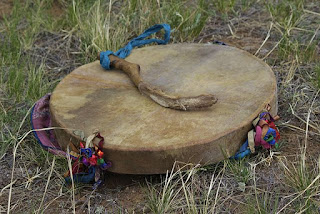The Great Mystery reveals itself as the powers of the four directions and these four powers provide the organizing principle for everything that exists in the world. There are four winds, four seasons, four phases of the moon, four stages to humanity's spiritual evolution, and four basic elements. The four elements are Air, Fire, Water and Earth. The four elements are basically the four forces or polarized rhythmic patterns that create and animate reality. Each element is associated with one of the four directions and has a unique essence or resonant quality that helps us evolve toward completion, toward harmony and balance. Collectively, they define the vibratory infrastructure that literally holds together our resonant field of reality.
Air is associated with the East and relates to spring, morning, the rising sun, expansion and control of the mind, and the breath of life. In the science of physics Air would be the equivalent of Electromagnetic Force, one of the four fundamental forces of nature. Fire is associated with the South and relates to summer, midday, growth, vitality, the sky, and illumination. Fire equates to the Strong Nuclear Force. Water is associated with the West and relates to autumn, twilight, assimilation, emotions, flow, the moon, death and rebirth, and transformation. It is the equivalent of Gravitational Force. Earth is associated with the North and relates to winter, darkness, the earth, purification, sensory awareness, completion, and the form-giving aspect of energy. It equates to the Weak Nuclear Force.
The sacred hoop or medicine wheel illustrates the sequence of development in the process of manifestation. Born of the silent emptiness of the center, vibration cycles around the periphery of the circle. Moving from East (Air) to South (Fire) to West (Water) to North (Earth), vibration bonds the elements, and then reverses its rotation toward emptiness to begin the cycle anew. The unmanifest essence of vibration precipitates this bonding sequence in order to manifest a desired form. The energy of vibration is alive and, because it is alive, it seeks ways in which to express or manifest itself. As Ute-Tiwa shaman Joseph Rael concludes in his book, Being and Vibration, "Apparently materialization occurs because vibration is seeking to purify the center (heart) of its newly formulated form."(1)
The four elements are the building blocks of nature and interact with humans in the creative process. The elements are living energies, which change and move as we think, and then take the form of our thoughts. Thought is the tool of the mind that shapes physical reality. Every thought, idea, or image in the mind has form and substance. Everything that we perceive began with a thought, for it is the blending of thought forms with the elemental rhythms that shape physical reality. It is the consciousness of humanity that holds the present physical form of all that we perceive. It is the mind that determines the destiny of forms. We are mind. Our Earth is mind. We live in a universe of mind. From photons to galaxies, life is conscious intelligent energy that can form itself into any pattern or function.
1. Joseph Rael and Mary Marlow, Being and Vibration (Tulsa: Council Oak Books, 1993), p 185.
Air is associated with the East and relates to spring, morning, the rising sun, expansion and control of the mind, and the breath of life. In the science of physics Air would be the equivalent of Electromagnetic Force, one of the four fundamental forces of nature. Fire is associated with the South and relates to summer, midday, growth, vitality, the sky, and illumination. Fire equates to the Strong Nuclear Force. Water is associated with the West and relates to autumn, twilight, assimilation, emotions, flow, the moon, death and rebirth, and transformation. It is the equivalent of Gravitational Force. Earth is associated with the North and relates to winter, darkness, the earth, purification, sensory awareness, completion, and the form-giving aspect of energy. It equates to the Weak Nuclear Force.
The sacred hoop or medicine wheel illustrates the sequence of development in the process of manifestation. Born of the silent emptiness of the center, vibration cycles around the periphery of the circle. Moving from East (Air) to South (Fire) to West (Water) to North (Earth), vibration bonds the elements, and then reverses its rotation toward emptiness to begin the cycle anew. The unmanifest essence of vibration precipitates this bonding sequence in order to manifest a desired form. The energy of vibration is alive and, because it is alive, it seeks ways in which to express or manifest itself. As Ute-Tiwa shaman Joseph Rael concludes in his book, Being and Vibration, "Apparently materialization occurs because vibration is seeking to purify the center (heart) of its newly formulated form."(1)
The four elements are the building blocks of nature and interact with humans in the creative process. The elements are living energies, which change and move as we think, and then take the form of our thoughts. Thought is the tool of the mind that shapes physical reality. Every thought, idea, or image in the mind has form and substance. Everything that we perceive began with a thought, for it is the blending of thought forms with the elemental rhythms that shape physical reality. It is the consciousness of humanity that holds the present physical form of all that we perceive. It is the mind that determines the destiny of forms. We are mind. Our Earth is mind. We live in a universe of mind. From photons to galaxies, life is conscious intelligent energy that can form itself into any pattern or function.
1. Joseph Rael and Mary Marlow, Being and Vibration (Tulsa: Council Oak Books, 1993), p 185.






